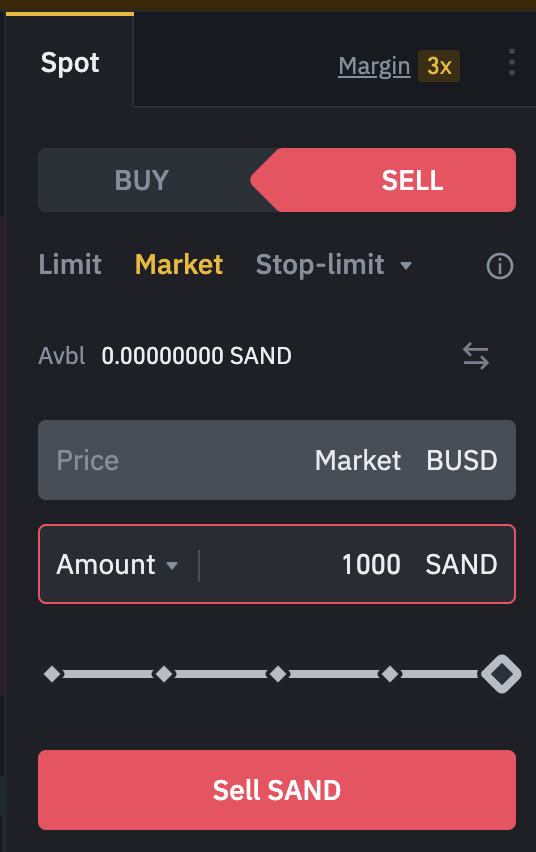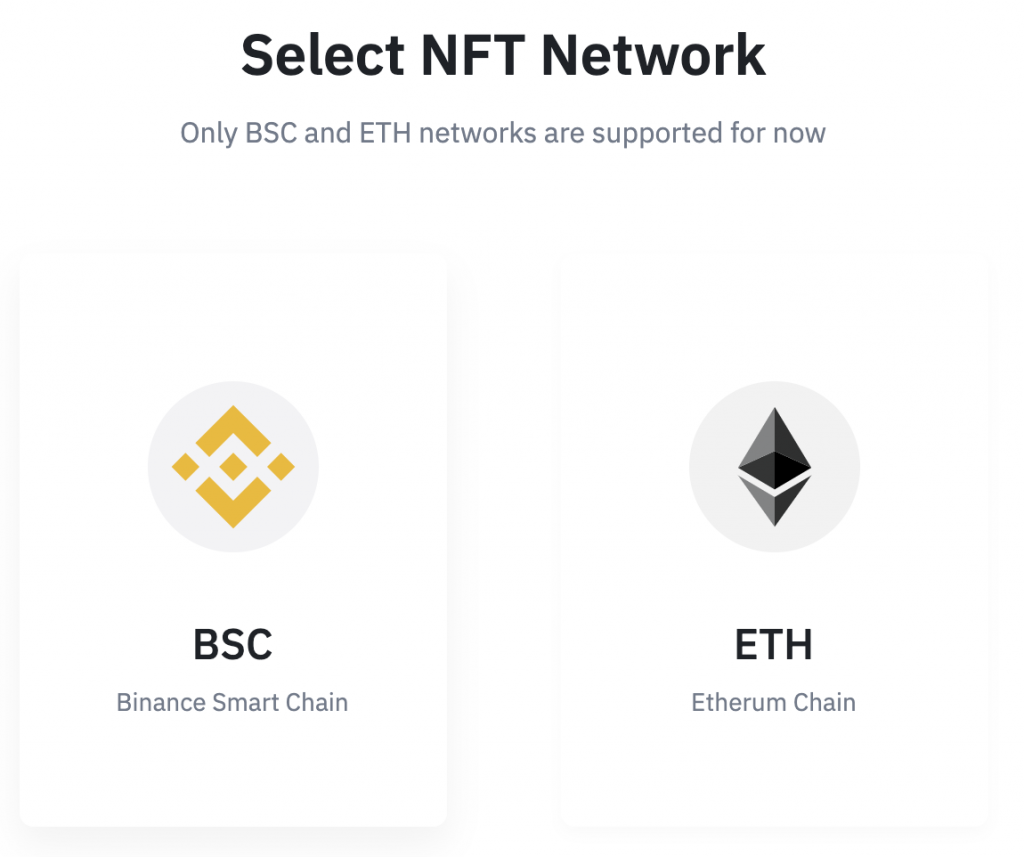Play-to-earn games allow users to farm or collect crypto and NFTs that can be sold on the market. By playing the game regularly, each player can earn more items or tokens to sell and generate an income. Some players have even begun to supplement or replace their salaries playing these blockchain games. However, such activity involves risk, as you typically need to put up an initial investment to purchase characters and items to play the game.
Blockchain helps guarantee the collectibility of these items and create working digital economies. Blockchain technology and NFTs allowed for the creation of digital items that are impossible to duplicate. This created the concept of digital scarcity.
To cash out, you’ll need to deposit your NFTs or crypto to an NFT marketplace or exchange like Binance. It’s unlikely you’ll be able to convert straight into fiat, so selling for a stablecoin first is a good idea.
Once you’ve sold your NFT or tokens, you can then convert the stablecoin into the fiat of your choice and withdraw using the available channels in your country. Another option is to use the stablecoin with a crypto card like the Binance Visa Card.
Introduction
Blockchain games have come a long way from trading simple Non-Fungible Token (NFT) collectibles like Cryptokitties. Now you have the chance to earn money playing crypto games, even if you don’t have the rarest NFT in your wallet.
The idea sounds appealing, as video games rarely give gamers the chance to make real-life income by selling digital assets. With this new model of play-to-earn games, users are now able to make money in the crypto world.
What are play-to-earn games?
Play-to-earn allows players to generate a steady stream of crypto income simply by playing the game. Each game’s mechanism can differ, but the rewards typically come from staking, farming a game’s currency, or generating tradeable NFT items. In older blockchain games, users relied mainly on random chances to make profits. Play-to-earn, however, has created in-game economies and business models where players can work for an income.
Axie Infinity on the Ethereum blockchain is one famous example. The game has combined traditional video game elements and gameplay with the old blockchain game model. For instance, Axie Infinity features an adventure mode, PvP battles, and tournaments – which are typically seen in the traditional gaming industry. The game is available for Windows, Android, Mac OS, and iOS.
How do play-to-earn games work?
With their mix of gaming and finance, play-to-earn games fall under the GameFi category. Each game provides financial incentives to play and progress. As mentioned, there is usually a grinding aspect of repeating specific actions that let users earn income in two main ways:
Earning in-game cryptocurrencies. One example would be Axie Infinity’s Smooth Love Potion (SLP), acquired by completing daily quests or battling monsters and players.
Earning or trading in-game NFTs. Each NFT may represent an item, character, or another collectible in the game. Depending on the game, these can be purely cosmetic or fulfill a use or purpose in-game.
There’s also a third alternative to earn with play-to-earn games: staking. Some NFT games allow users to lock up NFTs or cryptocurrencies in smart contracts, which in turn generates rewards. For example, staking MBOX tokens rewards users with MOMO NFT Mystery Boxes. Each one contains a random NFT of differing rarities, which can then be sold on the secondary market. However, to earn large staking rewards, you will need a very large initial deposit.
How does blockchain technology secure play-to-earn games?
Play-to-earn is not a new thing. There are many online games (usually MMORPGs) with fiat-based auction houses or secondary markets maintained by gold farmers. For cryptocurrency games, the critical difference is that these currencies and items exist on blockchains. A blockchain has several properties that easily prove ownership, legitimacy, and rarity.
You can think of a blockchain network like an immutable database. It is maintained by a distributed network of computers (users), each holding a copy of the blockchain data. This means that it’s virtually impossible for someone to change, duplicate or delete blockchain data.
As such, blockchain games can be developed in a way that prevents fraud or corruption, such as item duplication, gold hacks, and other exploits that are common in traditional games. A crucial part of an in-game item’s value is its rarity. With blockchain, there is no copy and paste. If an item is unique, there’s no way for it ever to be replicated. This helps to create real value for in-game items.
How much income do people make from play-to-earn games?
Gaming usually isn’t known for monetarily rewarding the average user. It can be challenging to understand that regular players can make an income from a blockchain game. In fact, many people are earning living wages from crypto games like Axie Infinity, especially in developing countries.
Farming can provide a more steady stream of income, where your earnings are proportional to your skills and the amount of time you play. This farming method has proved popular in the Philippines, where Axie Infinity has even become an alternative to unemployment benefits. Players can make between $200 to $1,000 (USD) monthly farming SLP, depending on the market price and playtime. Farming benefits are typically lower than the alternative of trading NFT creatures and items but are much safer for anyone who needs a regular income.
With games like Axie Infinity, you can even use your NFTs (Axies) to breed new ones. However, you cannot accurately predict the value of a newly bred Axie. As of October 2021, the most expensive Axie (Angel) sold went for $131,970 on Nov 7, 2020, and is now listed for 3,000 ETH. While these numbers sound tempting, predicting an average income for someone selling NFTs from play-to-earn games is difficult due to their random nature.

How to start playing play-to-earn games
Each play-to-earn game will have different requirements for new players. At the minimum, you’re going to need a crypto wallet like MetaMask or Binance Chain Wallet to store your crypto and connect it to the game.
You also might need to make an initial investment to play, such as setting up a team of characters or purchasing items used in-game. Entering a digital crypto-economy usually isn’t free.
As of October 2021, Axie Infinity requires an initial investment of around $600 to purchase three Axies. While this can be paid off within a few months of gameplay, it still creates a barrier to entry.
Another option is to look for the so-called scholarships, where you can basically borrow Axies from another player for free and then share the income you get with that player (referred to as the manager). In other words, a custom percentage of your income is given to the player providing the scholarship. Once you’ve created your starter team and have completed daily tasks and challenges, you’ll begin to steadily earn SLP, an ERC-20 token tradeable on Binance and other crypto exchanges.
How to cash out from play-to-earn games?
When playing NFT games, we mentioned there are two main options for earning: finding NFTs to sell or playing regularly to make a stream of in-game cryptocurrency.
These activities will give you NFTs, tokens, or both to sell on the secondary market. Depending on the exact cryptocurrencies and items you have, you may be able to sell both your NFTs and tokens on Binance. Ethereum and Binance Smart Chain (BSC) NFTs can be easily added to the Binance NFT Marketplace, but you will need to check whether the non-fungible tokens you want to sell are listed by Binance in your country. You will also need to verify your account by completing the KYC process.
Cashing out crypto from play-to-earn games
To cash out a token like SLP or SAND, you’ll need an exchange that offers your play-to-earn crypto in a tradeable pair. If you want to use your earnings in real life, you’ll also need to consider whether you can exchange the tokens for fiat currency (like US dollars and euros) and withdraw them to your bank account. Another option is using a crypto card to spend your crypto (e.g., the Binance Visa Card).
You can also convert your earnings into a stablecoin, but converting these into fiat will require an extra step. Your funds will be more stable in a coin like BUSD than in volatile crypto like SLP, SAND, or Bitcoin (BTC). Let’s look at a quick example.
From playing The Sandbox, you’ve managed to earn some SAND that you now want to sell. To cash out your SAND, you first need to deposit them into your Binance account.
If you’re using MetaMask or another crypto wallet, copy the deposit address into the sending wallet to transfer the cryptocurrency tokens. Don’t forget you will need crypto to pay your fees, such as BNB for Binance Smart Chain and ETH for Ethereum.

Then, on the exchange view, pick a suitable SAND pair to trade. SAND/BUSD is a good option, as BUSD is easily exchangeable for fiat currencies and can be used to lock in your earnings.

Next, sell your SAND using whatever order type you’d like. We’ve used a market order here, but you could also use a limit or stop-limit order.

Now you’ll have BUSD, which can be converted to fiat on BUSD markets like EUR/BUSD. Once you’ve sold for fiat, withdrawing your cash from Binance will change depending on the country you live in and the methods available. You can find more information on our FAQ page.
Cashing out NFTs from play-to-earn games
If you’ve earned in-game NFT items and collectibles in your play-to-earn game, you’ll need to trade them on an NFT exchange to cash out your earnings. The Binance NFT Marketplace has a deposit feature, allowing you to sell your NFTs directly on Binance. You can also use decentralized exchanges so long as your NFT is compatible with them.
To sell your NFTs on Binance, create or log into your Binance account. You’ll need to make sure your NFT is in a compatible wallet like Metamask. You’ll also need to complete KYC verification.
Next, head to the Binance NFT home page, click [User Center], and then [Deposit].

Select either BSC or ETH, depending on the network your NFT is on. You’ll then see the address that you’ll need to send your NFT to.

For more detailed instructions, check out How to Deposit NFT on Binance. Once you’ve imported your NFT, you can then sell it via an Auction or Fixed Price format in a variety of different cryptocurrencies. BUSD is a good option when setting up your sale, as it has little volatility and can be easily converted to fiat. See How to Sell an NFT on Binance NFT Marketplace to find the right method for you.
Tax implications
If you decide to use Binance to cash out your earnings, there are multiple options to choose from depending on your country and local regulations. However, it’s always important to check the tax implications of any exchanges you use to cash out. You may also be in a legal jurisdiction that affects the legality of crypto, so always do your own due diligence.
Closing thoughts
Play-to-earn games are a new development when it comes to earning with cryptocurrencies. With most new projects and ideas, you usually need to be first in the queue to take advantage of them. However, play-to-earn has made it possible for gamers to earn money. You should always be careful, though, as many games can be high-risk, unsustainable due to bad tokenomics, or even scams.
If you want to explore GameFi and play-to-earn more, head to the Binance NFT page. There are regular launches of NFT Mystery Boxes from the likes of MOBOX and My Neighbor Alice, all containing usable NFTs within the gaming world that can help get you set up.